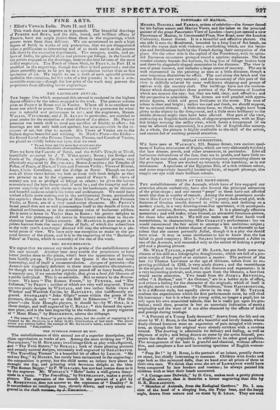PEEPS AT THE PRINT-SHOPS.
THE embellishments of the Annuals, which have of late engaged our attention almost exclusively, have also formed the principal attraction- of the print-shops ; and our recent " peeps" at them have not afforded' much else that is worthy of remark. Among the most prominent novel- ties is Miss FANNY CORBAUX'S " Juliet ;" a pretty dark-eyed girl, with' features of Grecian mould, dressed in white satin, and reclining on a modern couch, in a very drawing-room-like apartment, with accompani- ments of curtains, flowers, moonlight, &c. It is a pleasingly effective mezzotint ; and will make, when framed, an attractive furniture-picture, for those who admire it. We will not make use or that harsh word meretricious, in characterizing Miss CORBAUX'S performance : but we would recommend the fair artist to attempt a less ambitious subject ; when she may stand a better chance of success. It is no discredit to her talent that she cannot personify Juliet, though it is a pity she should have tried. It may be some satisfaction to her to know that she has failed in good company; Miss L. SHARPE having attempted a Juliet in one of the Annuals, and succeeded only to the extent of making a pretty girl and a pleasing picture.
Mr. WELD TAYLOR, a pupil of Mr. LANE, has put forth some spe. cimens of his skill as a lithographic draughtsman, which are full of a pro. anise worthy of the pupil of so eminent a master. The portrait of the late Sir Thomas Lawrence at the age of thirteen, taken from an en- graving published in 1783, is very nicely drawn ; and the resemblance to the original may be traced both in the features and expression: it is a very interesting portrait, and, even apart from the likeness, a face that would excite attention. Two heads from Sir JOSHUA REYNOLDS, called "A Recluse," and "An Outcast," are in a bolder style of effect, and evince a feeling for the character of the originals, which of itself is no slight merit in a student. "The Woodman,"from Gazasnonouon, is in a different style, but equally clever in its way. If Mr. TAYLOR. realizes the expectations which his first performances raise, he will rival his instructor : but it is when the young artist, no longer a pupil, has to rely upon his own unassisted talents, that he is really put upon his pro- bation • until then, promise is but an uncertain indication of merit ; originality and the want of it are alike obscured by the effects of habit and precept during tutelage.
"A Portrait of a Young Lady deceased," drawn from the life and on stone by W. C. Ross, is the head of a beautiful and lovely female' whose finely-formed features wear an expression of pain mingled with sweet ness, as though the fair original were already stricken with a cureless wound. The drawing is admirable for delicacy and feeling, as well as elegance of style ; and being drawn on stone by the artist himself, pos. sesses the charm of originality, in addition to its other good qualities. The arrangement of the hair is graceful and classical, without affecta- tion, and completes a fine and interesting specimen of English woman- hood.
"Peep Bo !" by H. Ross, is the portrait of an infant, prettily drawn
on stone, but chiefly interesting to mammas. Children with frocks and, caps look -so like animated dolls, that we hand over all prints of them to their own race. We think that even the art of LAWRENCE would have been conquered by lace borders and rosettes ; he always painted his. children with at least their heads uncovered.
"A Cottage near Duhvich," by D. Cox, makes such a pretty picture of English scenery, that it deserfes a better engraving than this by G. K. RICHARDSON. " Sk.etches of Animals, from the Zoological Gardens." No. I. con* sista of the head of a sleeping iion, the Polar bear, and thebarpy 'eagle, drawn from nature and on stone by E. LEAR. They are neat arulitiOcurate, but want spirit and relief. It requires )s inastery °rait- -4' render mere delineations of animals interesting and popnlar : fidelity and care are not the only elensents of Inrceali &Adria:Is and viper' DI style are also necessary, withofit which the creatures want life, and wear the appearance of having been drawn from their skins only. The beak of the harpy eagle is surely out of drawing. THOMAS LANDSEER'S masterly etchings of animals spoil us for any thing less effective, and in lithography we look for yet greater breadth and force.



























 Previous page
Previous page